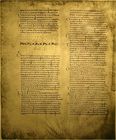 The content of the third lesson in this series begins on page 53 of Dean Burgon's The Revision Revised, and covers two examples of errors in the critical text. The first comes from Acts 18:7. It is very difficult to convey Burgon's explanation of this verse through a mere outline, so I will just let him speak for himself before proceeding to the next verse. Here is Burgon's explanation of the error contained in the critical text rendition of Acts 18:7: "Another corruption of the text, with which it is proposed henceforth to disfigure our Authorized Version, (originating like the last in sheer accident,) occurs in Acts xviii. 7. It is related concerning S. Paul, at Corinth, that having forsaken the synagogue of the Jews, “he entered into a certain man's house named Justus” (ὀνόματι Ἰούστου). That this is what S. Luke wrote, is to be inferred from the fact that it is found in almost every known copy of the Acts, beginning with a d g h l p. Chrysostom—the only ancient Greek Father who quotes the place--so quotes it. This is, in consequence, the reading of Lachmann, Tregelles, and Tischendorf in his 7th edition. But then, the last syllable of “name” (ΟΝΟΜΑΤΙ) and the first three letters of “Justus” (ΙΟΥΣΤΟΥ), in an uncial copy, may easily get mistaken for an independent word. Indeed it only wants a horizontal stroke (at the summit of the second Ι in ΤΙΙΟΥ) to produce “Titus” (ΤΙΤΟΥ). In the Syriac and Sahidic versions accordingly, “Titus” actually stands in place of “Justus,”—a reading no longer discoverable in any extant codex. As a matter of fact, the error resulted not in the substitution of “Titus” for “Justus,” but in the introduction of both names where S. Luke wrote but one. א and e, the Vulgate, and the Coptic version, exhibit “Titus Justus.” And that the foregoing is a true account of the birth and parentage of “Titus” is proved by the tell-tale circumstance, that in b the letters ΤΙ and ΙΟΥ are all religiously retained, and a supernumerary letter (Τ) has been thrust in between,—the result of which is to give us one more imaginary gentleman, viz. “Titius Justus;” with whose appearance,—(and he is found nowhere but in codex b,)—Tischendorf in his 8th ed., with Westcott and Hort in theirs, are so captivated, that they actually give him a place in their text. It was out of compassion (we presume) for the friendless stranger “Titus Justus” that our Revisionists have, in preference, promoted him to honour: in which act of humanity they stand alone. Their “new Greek Text” is the only one in existence in which the imaginary foreigner has been advanced to citizenship, and assigned “a local habitation and a name.” ... Those must have been wondrous drowsy days in the Jerusalem Chamber when such manipulations of the inspired text were possible!"
Luke 23:45 I. The English Translations A. KJV – “And the sun was darkened, and the veil of the temple was rent in the midst.” B. ESV – “while the sun’s light failed. And the curtain of the temple was torn in two.” II. The Greek Texts A. Textus Receptus – “καὶ ἐσκοτίσθη ὁ ἥλιος” - "and darkened was the sun" B. Critical Text – “τοῦ ἡλίου ἐκλιπόντος” - "the sun was eclipsed" III. A Question A. Why do the modern versions translate “eclipontos” as “light failed” rather than as “was eclipsed"? B. The scholars who use the English translation of “light failed” are the very same ones who assert that “eclipontos” is the correct Greek word. C. Answer: There was no eclipse of the sun at the time of Christ’s crucifixion. IV. An Error with a History A. This particular error was actually written about by the Church fathers. - Origen (A.D. 186-253) explained that unbelievers changed the word to eclipse in an effort to discredit the account. - Jerome (A.D. 347-420) made the same argument. B. Every church father who quoted this phrase used the wording found in the TR. C. Every 2nd and 3rd century source agrees with the TR. V. Additional Support for the Textus Receptus A. In total, there are only 3 manuscripts and 1 ancient version which read “eclipsed” instead of “darkened." B. There are more than 1400 manuscripts, versions and quotations which agree with the TR. C. The modern critics themselves prove that the error in their text is an embarrassment by hiding that error in their English translations.
0 Comments
Your comment will be posted after it is approved.
Leave a Reply. |
Bill Fortenberry is a Christian philosopher and historian in Birmingham, AL. Bill's work has been cited in several legal journals, and he has appeared as a guest on shows including The Dr. Gina Show, The Michael Hart Show, and Real Science Radio.
Contact Us if you would like to schedule Bill to speak to your church, group, or club. "Give instruction to a wise man, and he will be yet wiser: teach a just man, and he will increase in learning." (Proverbs 9:9)
Search
Topics
All
Archives
June 2024
|


 RSS Feed
RSS Feed